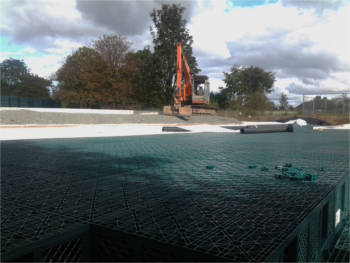Falkirk Council has protected a long-standing flooding risk from peak rainfall with a stormwater storage solution that saved space and preserved nearby recreational facilities for local residents.
Crossing under the main Edinburgh to Stirling railway, the Chapel Burn winds its way through and around Larbert town before eventually discharging into the River Carron and the Firth of Forth. It has caused repeated flooding close to the centre of Larbert, particularly in 2006 when a railway cutting was inundated and closed the line.

Laying the ground work for flood protection near Larbert
After considering several solutions, Falkirk Council designed and specified a new cellular storage surface water flood alleviation solution. The storage space needed was minimised with a Hydro-Brake Optimum vortex flow control.
'A hydro brake flow control device allowed us to use the smallest amount of storage required for the back-up volume. We evaluated the solution for attenuation storage and found it provided an ideal combination of effectiveness and low construction costs, in a restricted space and it could be landscaped over thus retaining the popular recreational area,' Falkirk Council’s engineering design officer, John Divers, said.
Initial proposals to manage the risk of seasonal flooding at the site had centred on a permanent attenuation pond adjacent to the railway banking to act as an overflow for the Chapel Burn. However, there were several difficulties with this solution:
- The local sandy soil structure, the railway bank would be destabilised by the saturated ground and put at risk.
- The popular recreational area would be reduced in size by a large pond reducing its local amenity
-The proposed site for the pond also covered a Scottish Water 1200 mm drinking water main with unacceptable risks to that installation.
As the topography is flat, any solution had to be compatible with the low head parameters. The shallow dimensions of the 1480 m2 Hydro Stormbloc tank with a 1.01 metre depth, enabled the required 5 l/s maximum discharge from the Hydro-Brake Optimum back into the Chapel Burn to be achieved without difficulty.
“The rail line originally had a syphonic device to channel the burn under the bank, installed when the line was built, but it wasn’t coping with the increasing flood risk from the Chapel Burn. The railway closure made action more urgent, however rebuilding a larger syphon under the line would have caused major disruption to rail services,' Mr Divers said.
'The Chapel Burn can experience very rapid changes in level and the complete installation was designed with a tailor-made concrete drain channel installed alongside the burn. This acts as a weir, discharging into the attenuation tank, and provides instant relief when the burn starts to overflow.'
Register now for full access
Register just once to get unrestricted, real-time coverage of the issues and challenges facing UK transport and highways engineers.
Full website content includes the latest news, exclusive commentary from leading industry figures and detailed topical analysis of the highways, transportation, environment and place-shaping sectors.
Use the link below to register your details for full, free access.
Already a registered? Login